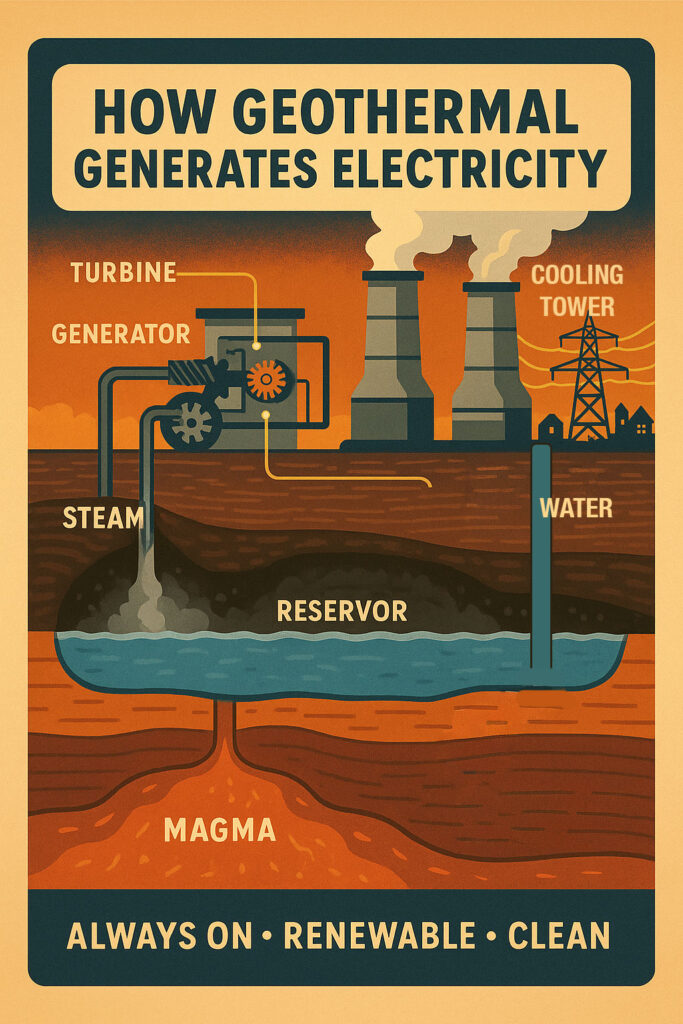Key Takeaways
- Unlike solar or wind, geothermal runs 24/7, rain or shine, making it one of the most dependable renewable energy sources.
- Geothermal supplies less than 1% of U.S. electricity today, but the U.S. is the world leader in production, and new drilling technologies could unlock much more.
- With low emissions, a small land footprint, and the ability to recycle water back underground, geothermal offers a long-term, eco-friendly energy solution.
Geothermal energy comes straight from the Earth itself. The word “geothermal” literally means “heat from the Earth.” Beneath our feet, the Earth’s core radiates enormous amounts of heat, some areas have reservoirs of hot water and steam close enough to the surface that we can tap into them. People have used geothermal energy for centuries, from natural hot springs to modern-day power plants. It’s one of the few renewable energy sources that’s available 24/7, rain or shine, without needing batteries or storage.
How Geothermal Generates Electricity

Turning heat into electricity might sound like magic, but the process is surprisingly straightforward. Wells are drilled into underground reservoirs of hot water or steam. That hot fluid is brought to the surface and used to spin turbines, which generate electricity. There are three main types of geothermal power plants:
- Dry Steam Plants: The simplest form, where steam is drawn directly from underground and spins a turbine.
- Flash Steam Plants: The most common type, where hot water under high pressure is brought up, flashes into steam, and drives turbines.
- Binary Cycle Plants: A more advanced system that uses hot water to heat a secondary fluid with a lower boiling point, producing vapor to spin turbines.
Together, these technologies allow us to turn underground heat into reliable power for homes, businesses, and entire communities.
Advantages of Geothermal Energy
Geothermal has a lot going for it:
- Renewable & Sustainable: As long as the Earth’s heat exists (and that’s billions of years), we’ll never run out.
- Reliable: Unlike solar or wind, geothermal is available day and night, regardless of weather.
- Low Emissions: It produces far fewer greenhouse gases compared to fossil fuels.
- Small Land Footprint: A geothermal plant takes up less land than a solar or wind farm of equivalent capacity.
Disadvantages of Geothermal Energy
It’s not without its challenges:
- Location-Dependent: Not every place has accessible geothermal resources.
- High Upfront Costs: Drilling wells and building plants can be very expensive.
- Potential Environmental Impacts: In some cases, geothermal plants can release trace gases or cause land subsidence.
- Resource Limits: If not managed carefully, local geothermal reservoirs can cool down over time.
Geothermal in the U.S. Electricity Mix
Geothermal plays a relatively small but important role in the U.S. energy picture. Today, geothermal accounts for about 0.4–0.5% of total U.S. electricity generation, roughly enough to power 3–4 million homes. While that’s modest compared to natural gas or renewables like wind and solar, geothermal’s reliability makes it especially valuable. The U.S. is actually the world leader in geothermal electricity production, generating about a quarter of global capacity.
Where Geothermal is Used Most
Not surprisingly, geothermal plants are most common in the western United States, where hot underground reservoirs are closest to the surface. The biggest concentrations are found in:
- California: Home to “The Geysers,” the largest geothermal complex in the world.
- Nevada: The state ranks second in U.S. geothermal capacity.
- Utah, Oregon, Idaho, Hawaii: Each has growing geothermal projects.
Globally, countries like Iceland, the Philippines, and Kenya also rely heavily on geothermal because of their volcanic activity.
The Future of Geothermal
Geothermal may play a much bigger role in the future. Emerging technologies are making it possible to tap deeper resources, even in areas without natural hot springs. Enhanced Geothermal Systems (EGS), for example, use advanced drilling to create artificial reservoirs in hot rock. If widely deployed, EGS could dramatically expand geothermal’s reach.
Beyond electricity, geothermal is also being used for direct heating and cooling, from warming greenhouses to supplying district heating systems. On the residential side, geothermal heat pumps are becoming a popular way to heat and cool homes efficiently.
Other Interesting Facts
- The very first geothermal power plant in the world was built in Italy in 1904.
- Geothermal energy is one of the few sources that’s truly “always on,” making it an excellent partner to intermittent renewables like wind and solar.
- The Department of Energy estimates that with next-generation technologies, geothermal could provide 8.5% of U.S. electricity by 2050.
Geothermal energy may be a small slice of the pie today, but its steady, clean, and renewable nature makes it a quiet powerhouse in the push toward a sustainable energy future.
FAQs About Geothermal Energy
What is geothermal energy?
How does a geothermal power plant work?
Where is geothermal energy used most in the U.S.?
How much electricity does geothermal provide?
Can geothermal energy run out?
About the Author
LaLeesha has a Masters degree in English and enjoys writing whenever she has the chance. She is passionate about gardening, reducing her carbon footprint, and protecting the environment.
